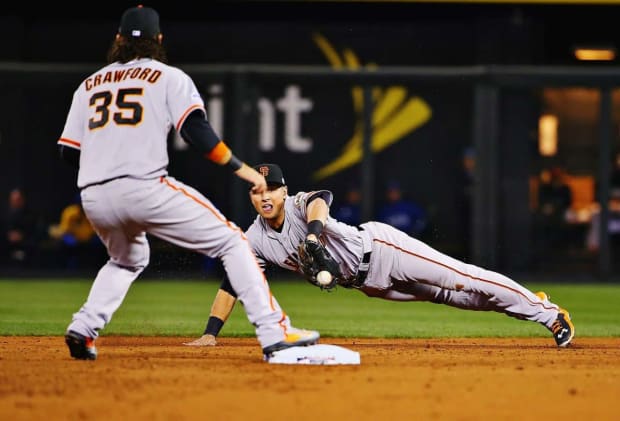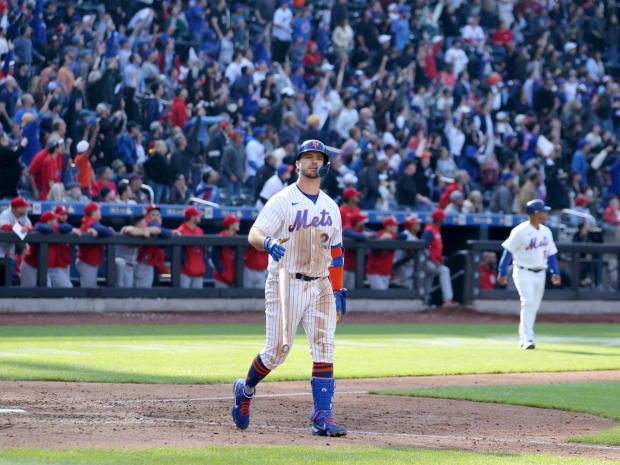
Al Tielemans/Sports Illustrated
For nearly as long as I can remember, whenever anyone asked me who was my favorite baseball player, I said Jorge Posada. He was the player I wanted to emulate from the time I was little. Like Jorge, I didn’t wear batting gloves. Like Jorge, I slightly hunched over in my batting stance (until I realized it was easier to hit standing more upright). Like Jorge, I was a switch-hitting catcher.
Then, sometime in middle school, circa 2008, I heard about this local kid named Joe Panik. By that point, he was one of the best high school players in the state of New York and had committed to play baseball at St. John’s. And he lived five minutes from my house in Hopewell Junction and went to John Jay High School, where I would attend two years later. Suddenly, I had a new player who I wanted to be like, a player to whom I had a connection.
Of course, that connection was tangential at best—Panik and I never went to school together, and I’ve met him on less than a handful of occasions—but that didn't matter to me. I had a player in whose footsteps I could follow. He gave me and my friends hope that we could be like him.
Last night Panik, 31, confirmed news that was first reported by the New York Post’s Jon Heyman: Panik has retired from Major League Baseball after eight seasons. The Giants selected him in the first round (29th) in the 2011 amateur draft as a shortstop; he moved over to second base as he ascended through the minor league system because Brandon Crawford had already established himself as San Francisco’s shortstop of the future. Panik debuted on June 21, 2014, and soon became the team’s starting second baseman. In 73 games, he slashed .305/.343/.368 and provided slick defense to help the Giants make the playoffs for the third time in five seasons. He went 3-for-5 in their NL Wild Card Game win over the Pirates, and he hit a key home run off Cardinals ace Adam Wainwright in NLCS Game 5, which the Giants won on Travis Ishikawa’s walk-off, series-clinching three-run homer in the ninth inning.
The highlight of Panik’s career came in Game 7 of the World Series against the Royals. With Lorenzo Cain on first base with nobody out In the third inning and the score tied 2–2, Eric Hosmer hit a ground ball up the middle. Diving to his right, Panik snagged the grounder and flipped with his glove to Crawford, who fired to first for what was eventually ruled a double play after a replay review. Had the ball gone through, Cain would’ve advanced to third and given Kansas City runners on the corners with nobody out and a chance to break the game open. Instead, the next batter, Billy Butler, stepped to the plate with nobody on and two outs. He grounded out to short to end the inning. Madison Bumgarner came out of the bullpen to start the fifth and pitched five scoreless innings on two days’ rest to secure the Giants’ third World Series title in five years.

The next year, Panik hit .312/.378/.455 (129 OPS+) with 3.5 WAR and made his only All-Star team before a back injury limited him to just four games over the final two months of the season. He won a Gold Glove in 2016 and finished the ’17 season as an above-league-average hitter (102 OPS+), though he was never the same player after his ’15 All-Star campaign. After San Francisco released him in early August ’19, he signed with the Mets and posted a respectable .277/.333/.404 over 39 games with New York. He latched on with the Blue Jays in ’20 before they traded him to the Marlins in late June ’21 and finished out what turned out to be his final season with Miami.
“I just knew it was time for me to retire,” Panik told the San Francisco Chronicle last night. “I just felt in my heart and my head, I was ready for the next chapter of my life.”
Last year his wife, Brittany, who also grew up in Hopewell Junction and went to John Jay High School, gave birth to their daughter, Mikayla. “I want to be home with my family,” Panik told The Chronicle. (Shout out to Brittany’s younger brother, Chris Pinto, who is a former teammate of mine.)
Most of what has been written about Panik over the last 24 or so hours focuses on what I included above about his time in MLB, which veteran baseball writer Henry Schulman, formerly of the Chronicle, called “a short but extraordinarily impactful career.” That’s an apt summation of Panik’s time in MLB, and for almost everyone who isn’t from Dutchess County, N.Y., it is pretty much the end of his story. Yet, for those of us who looked up to Panik before he made the majors, his impact endures.
Panik had just finished his first minor-league season in the early fall of 2011 when he came to one of our high school baseball practices to get in some fielding work before going to the Arizona Fall League. His older brother Paul was one of our assistant coaches, and after we finished our practice, Paul hit fungos to Joe, who fielded them and threw over to me at first base.
The following winter, Panik showed up to our indoor workouts and gave us tips during batting practice. I don’t remember the specific pointers he gave me, but I remember he complimented my switch-hitting. I’d be lying if I made some grand statement about how much I learned from Panik. At that point, I knew I wasn’t going to be a professional baseball player. But I don’t think it’s too much of a stretch to say that he made it easier for me to believe that I could become a baseball writer. If someone from my hometown could become an All-Star, a Gold Glove winner and a World Series champion, then maybe, just maybe, I could someday land a job covering baseball for Sports Illustrated.
For that, I’d like to say thank you, Joe. And congrats on one hell of a career.
Have any questions for our team? Send a note to mlb@si.com.

Brad Penner/USA TODAY Sports
1. THE OPENER
“The current moment, in other words, is precisely what Mets fans might have feared from the very start of spring training. Yet this specific manifestation of it—at least right now—does not feel like the downfall we may have expected it to be. A setback? Of course. But a road straight to collapse? No. Or, at least, it doesn’t have to be.”
That’s Emma Baccellieri, writing in her column from this morning about the Mets, who are down both Max Scherzer and Jacob deGrom but still hold first place in the NL East.
Are the Mets Fundamentally Cursed? This Is the True Litmus Test by Emma Baccellieri
Somehow, the Metaphorical Mets keep winning despite everything going wrong.
2. ICYMI
Let’s run through some of our other great SI baseball stories from this week.
Albert Pujols Is Having the Time of His Life by Emma Baccellieri
The 42-year-old Cardinals legend is stealing bases, pitching and reminding us each day that some nostalgia trips can be both fun and productive.
Making the Case for the American Baseball Cup by Will Laws
Baseball is the sport best positioned in the U.S. for a competition similar to England’s FA Cup. Bring on the American Baseball Cup.
How Concerned Should We Be About These Five Star Shortstops? by Nick Selbe
Corey Seager, Carlos Correa, Marcus Semien, Javier Báez and Trevor Story all are off to disappointing starts with their new teams. Is it time to panic?
The Yankees Are the Class of MLB This Season by Tom Verducci
They are a club without an obvious flaw, and Aaron Judge is better than ever. Plus, notes on the return of glove-first shortstops and Taylor Ward’s breakout season.
MLB Power Rankings: The Dodgers Are Finally Dethroned by Nick Selbe
For the first time all year, we have a new No. 1 team.
Inside the Reds’ Historically Bad Start to the Season by Stephanie Apstein
This is not a full teardown, the kind designed to accumulate prospects and stockpile draft picks. This is just the bill coming due for years of bad management.
3. WORTH NOTING from Emma Baccellieri
On Wednesday, Nick Pivetta did something increasingly rare: He pitched a complete game. It made him just the third starting pitcher to complete nine innings this year. (The other two were Reid Detmers, in his no-hitter, and Walker Buehler.) Of course, this tracks with all that we’ve seen in starting pitching lately. But it’s striking just how much the trend has shifted.
The average start this year has lasted 81 pitches (5.0 IP). That’s down from 83 pitches last year. If you go back a decade, to 2012, it’s down from 95 pitches (5.9 IP)—almost the difference of a full inning. But one thing to watch? On May 30, the number of pitchers allowed on a roster will go down to 13. (To refresh: This was originally supposed to happen in ‘20! It’s now been delayed for more than two seasons by the effects of the pandemic and lockout.) The resulting change might not be dramatic. But it should be something.
4. W2W4 from Matt Martell
My eyes are going to be on the back-to-back MLB debuts of Nolan Gorman and Matthew Liberatore, the Cardinals’ top hitting and pitching prospects, respectively. Manager Oli Marmol said yesterday that Gorman will be in the lineup at second base in tonight’s game against the Pirates in Pittsburgh and that Libertore will make his first big league start on Saturday.
Gorman and Liberatore grew up close friends and played youth baseball together in the Phoenix area, though they attended different high schools. They were each selected in the first round of the 2018 MLB draft; the Rays picked Liberatore 16th before the Cardinals took Gorman three picks later. The two buddies were reunited when St. Louis acquired Liberatore in the trade that sent Randy Arozarena to Tampa Bay in January ‘20.
Now, they reach the majors at the same time and play their first game in the same series. That’s pretty cool.
5. THE CLOSER from Emma Baccellieri
If you have not yet seen this marvelously executed hidden ball trick from Double-A Frisco RoughRiders first baseman Trey Hair, please enjoy. Happy Friday!
That’s all from us today. We’ll be back in your inbox next Friday. In the meantime, share this newsletter with your friends and family, and tell them to sign up at SI.com/newsletters. If you have any questions or comments, shoot us an email at mlb@si.com.